The importance of a company’s customer service department cannot be underestimated as customers really are the lifeblood of any business, and making and keeping them happy will make or break your business.
But how do you really know how well or poorly your customer service department is doing? How do you know what customers are truly thinking or how they feel about the customer experience? How do you get the data to determine the patterns and trends that are helping or harming the company?
We’ve put together a list of the 20 most important customer service metrics you should be tracking. These hard numbers will allow you to quantify your performance to achieve your customer service mission, i.e., achieve and maintain customer satisfaction and build a fiercely loyal following.
Companies that make a steadfast commitment to customer happiness attract new customers, retain current customers, make more sales, expand referrals, and grow revenue.
We’re going to look at two types of metrics:
- Organizational Metrics: These aim to enter the customers’ heads and determine what they think about your product or service and if they’re happy about it.
- Operational Metrics: These measure the performance of your customer service agents and get insights into the performance of your customer service department.
Let’s take a closer look at those 20 customer service metrics you should be monitoring very, very closely.
1. Customer Effort Score (CES)
The CES measures a customer’s effort to get a request fulfilled such as returning a product, getting answers to queries, or resolving any issues. A less effort means a better CES. Customers are more likely to be loyal to those brands that are the easiest to do business with and offer a seamless customer experience (CX).
How to Measure: To measure CES, a company can survey its customers to rate their experience on a numerical scale. For example, just after a refund, you can ask the customer, “On a scale of 1 to 10, how much effort did it take to return your product?” The average number of all the responses would be the CES.
Tip: Focus on preemptive customer service, where you solve problems before they arise by anticipating issues that may come up for your customers.
2. Net Promoter Score (NPS)
NPS lets you track customer satisfaction and loyalty by asking customers how likely they are to recommend your business to their friends, family, and colleagues, on a scale of 0 to 10.
The surveys are sent right after the interaction with the company and then organized into one of three groups: promoters (who select the scores of 9 or 10), passives (7 or 8), and detractors (6 or lower).
How to Measure: Subtract the percentage detractors from the percentage promoters and remove the percentage sign from the final result:
NPS = % promoters – % detractors
Tip: Reach out to detractors and passives personally to find out the issues and resolve them. This way, you can build trust and increase NPS by letting them know that the company takes its customers’ complaints seriously and leaves no stone unturned to resolve them.
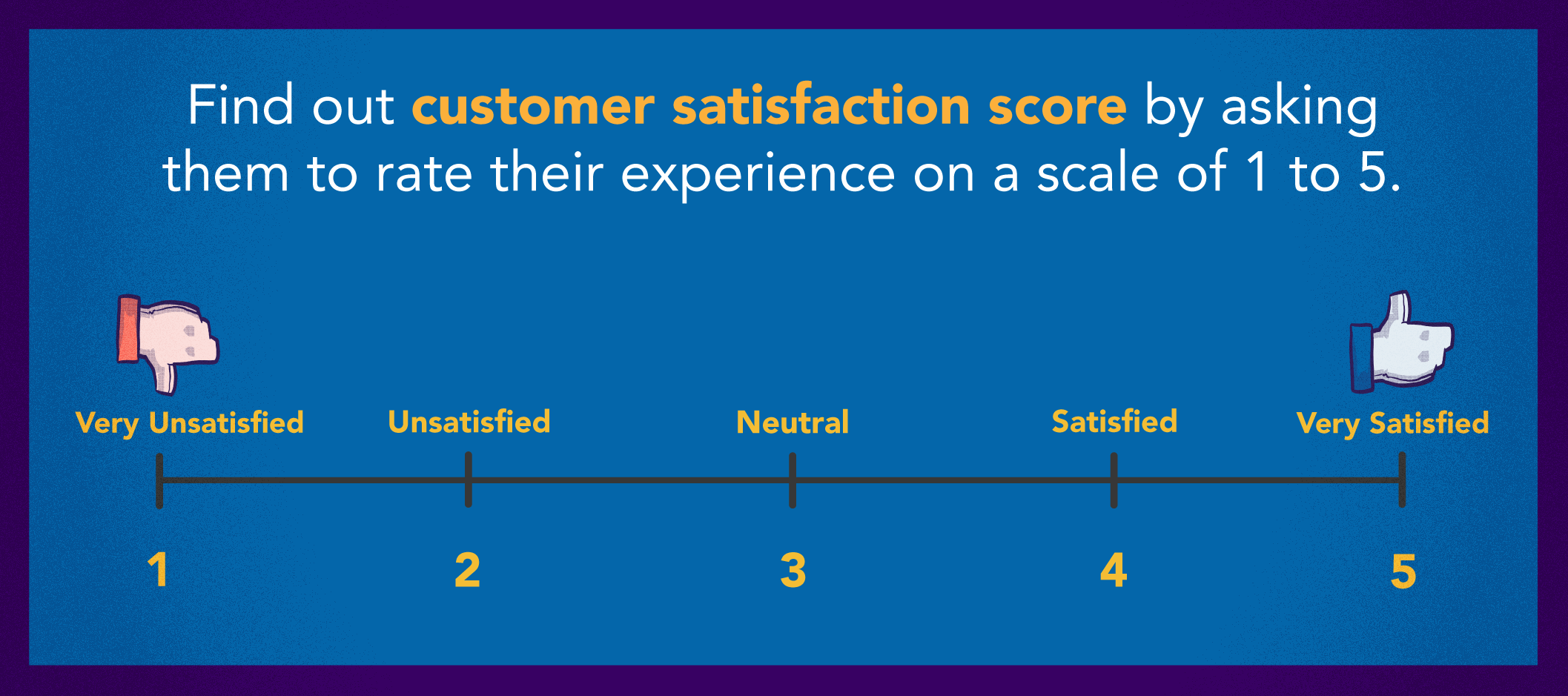
3. Customer Satisfaction Score (CSAT)
Find out how your buyers really feel by sending them surveys right after their interaction with customer support to see how they’d rank their experience on a scale of 1 to 5. It also helps to include open-ended questions so that people can share their opinions and ideas of how your company can improve.
How to Measure: To calculate the CSAT, we only include satisfied (4s) and very satisfied (5s) customers in the calculation as they’re believed to be the best predictors of customer retention. Add them up and divide the sum by the total number of responses and multiply by 100.
(Number of customers who selected 4 and 5 / Total number of survey responses) x 100
Tip: Offer multichannel support so you can solve your customers’ issues through email, phone calls, chat, or even social media, depending on the method with which they feel the most comfortable.
4. Customer Experience Rating
CX is everything these days, as your relationship with buyers is the foundation for your business. From invoice payments to support requests, every interaction between customers and companies can build or break that relationship. This metric helps companies understand satisfaction rates and boost customer retention.
How to Measure: The best way to measure the CX is to collect as much feedback as possible through surveys and in-person meetings. Then analyze the information to get a handle on where the company is excelling and where it’s falling short.
Tip: One way to improve the customer experience is to incorporate conversational commerce tech, machine learning, and artificial intelligence, such as live chats, chatbots, and emotion analytics.

5. Customer Churn
Churn is when customers stop doing business with a company. Since acquiring new customers is 5 to 25 times more expensive than retaining old ones, this metric should be a priority. Companies should be able to identify how many customers are leaving as it will reflect the effectiveness of their marketing efforts and customer satisfaction.
How to Measure: Subtract the number of customers at the end of the month from the number at the beginning of the month and divide the difference by the latter number.
(Number of customers at the start of the month – Number of customers at the end of the month) / Number of customers at the start of the month
Tip: Keeping track of customers’ habits and activities can help you determine if they will stay or leave. If you notice that clients haven’t logged into their accounts for months or if their sessions are infrequent or unusually short, you can get in touch with them and try to strengthen your relationship.
6. Customer Retention Rate
Customer retention is critical because existing customers are likely to spend more than new ones. A rising customer retention rate is a good sign because businesses that retain customers long-term have a customer relationship based on loyalty and trust.
How to Measure: Count the number of customers at the end of a specific period (month, quarter, etc.) and subtract the number of new customers acquired during that time. Then divide the difference by the number of customers you had at the beginning of the period.
(Total number of customers at the end of a period – Total number of new customers in that period) / Total number of customers at the beginning of that period
Tip: Boost retention by showing appreciation for your customers with a loyalty program, offering them incentives and rewards if they continue to buy from you.
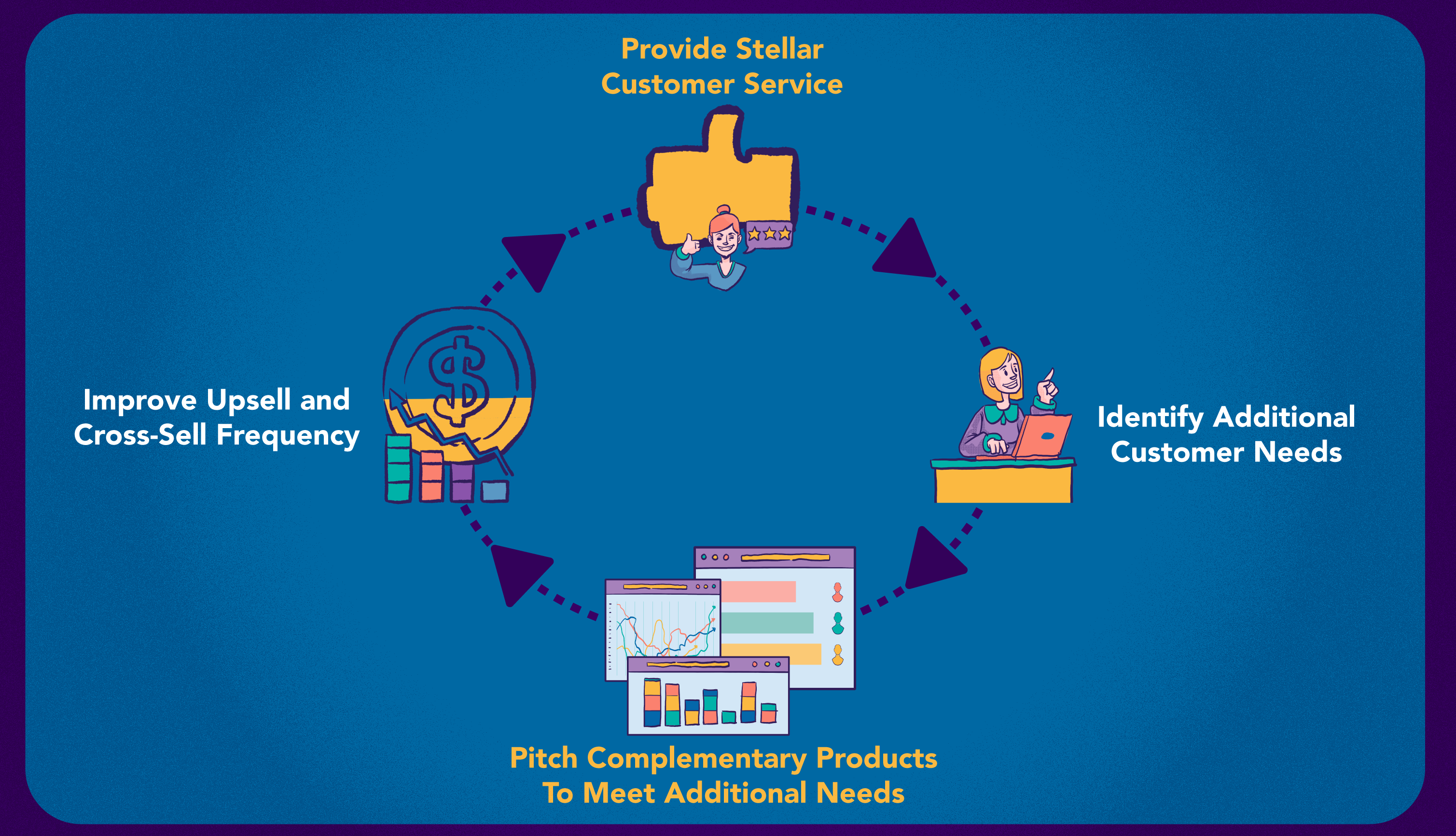
7. Upsell and Cross-Sell Frequency
While upselling and cross-selling may seem to belong to the sales department, they’re also a customer service metric because customer service agents are encouraged to sell complementary products and additional features to customers. If these rates are high, it means the customer service reps are doing a great job and customers are happy to buy more from you.
How to Measure: There are several ways to measure this metric; for example, if the average sales volume or number of products for each customer increases, it can mean that upselling or cross-selling has been successful.
Tip: Make sure reps only try to upsell those customers who will benefit from a product or service. Otherwise, the interaction may feel too “salesy” and might drive customers away.
8. Next Issue Avoidance (NIA)
This metric refers to the number of customers who have submitted more than one support request for the same issue or product. Tracking it allows companies to identify patterns, anticipate customers’ questions, and be more proactive. Customer service agents need to shift their mindset in this case, from “How can I finish this call quickly?” to “How can I avoid related calls at a later date?”
How to Measure: One way to measure NIA is to track the number of repeat calls to a contact center or helpline within a set period.
Tip: Keep track of customers’ history, past interactions, and historical data with a CRM tool so that agents can personalize the conversation. Personalized interaction can boost customer satisfaction and retention, and just a 5% increase in customer retention can boost profits by 25% to 95%.
9. Average Resolution Time
Resolution time refers to the amount of time it takes customer service agents to resolve customers’ issues. Resolution times are critical and customers often rank it among one of the most important aspects of customer service.
How to Measure: Divide the total resolution time for all support tickets resolved in a specific time frame by the total number of tickets resolved in that same time frame.
Total resolution time for all resolved tickets / Number of tickets resolved
Tip: Make sure your company has an in-depth knowledge base with extensive product and service information and answers to FAQs that both customers and customer service agents can access.
10. Average Reply Time
Customers want to get their issues resolved immediately, so this is an important metric that refers to the median amount of time it takes to handle your customer calls. The lower the number, the better. This metric is best understood when compared with the previous average reply times to understand whether or not the customer service agents are improving their performance.
How to Measure: For this metric, we divide the number of responses by the time taken to respond to those support tickets.
Total response time during a specific period / The number of responses in that same period
Tip: Have agents use an email autoresponder to let customers know that their ticket has been received and the team is already working on their issue. Also, letting them know what will happen next can go a long way towards reducing negative sentiment, which usually occurs when they feel ignored.
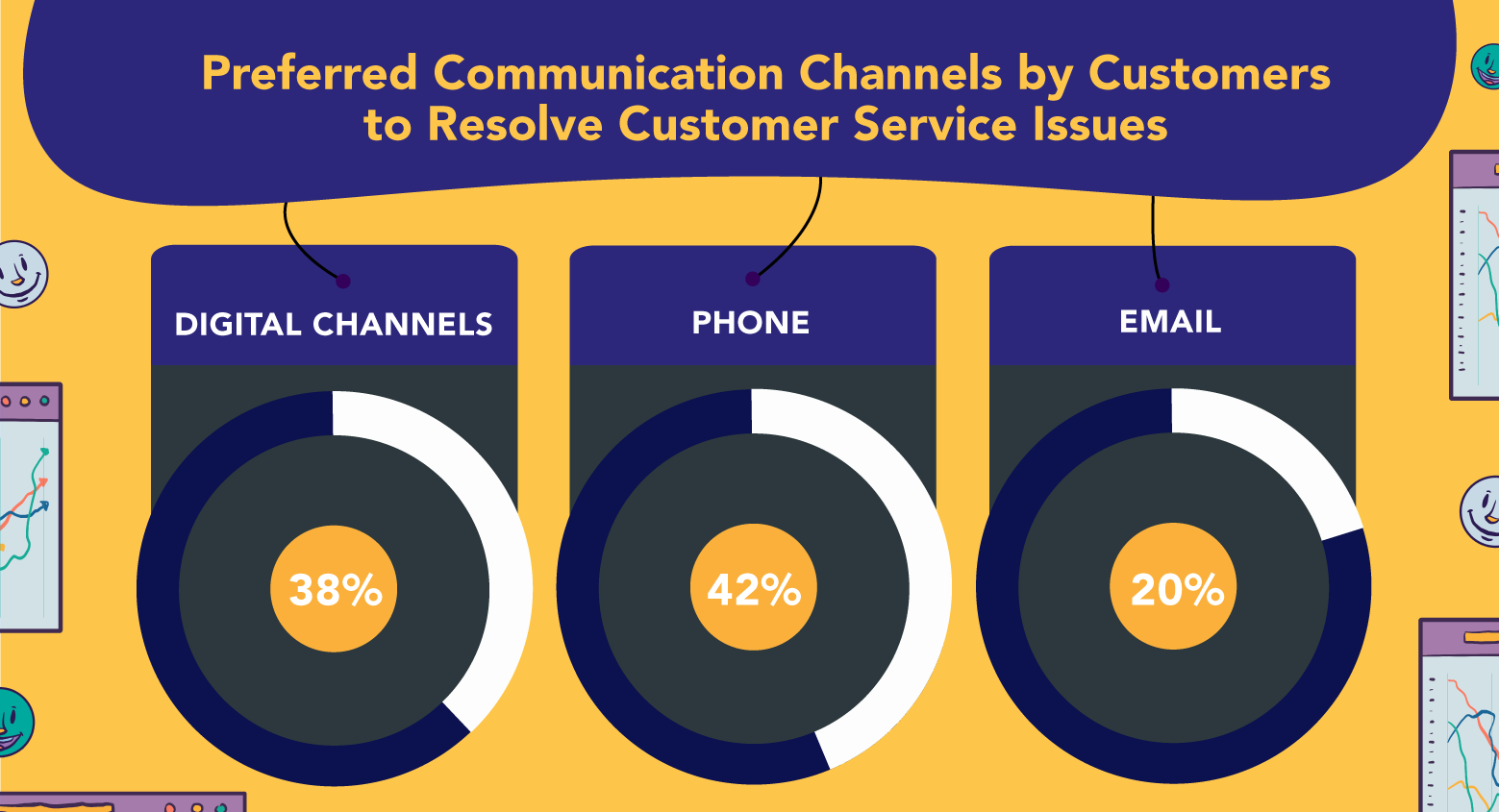
11. Preferred Communication Channel
This metric tells companies which communication channels their customers prefer and offers other insights into their general preferences. Nowadays, it’s essential to use multiple channels for support and assign the correct number of representatives to each channel, so no request for help gets ignored.
How to Measure: The best way to measure this is to survey your customers and determine which channels are the most important for your company—phone, face-to-face, live chat, social media, email, video, etc.—and distribute agents accordingly.
Tip: Once you’ve determined the most important channels, offer stellar support by personalizing interactions and ensuring that agents use those unified communication channels as effectively as possible.
12. Tickets Solved
This metric essentially reveals the number of tickets that have changed status to “solved” or “closed.” Many companies set a “daily tickets solved” target to track the performance of their agents. Of course, performance will vary, so it’s essential to track the daily average over time to identify trends.
How to Measure: To calculate tickets solved, we divide the number of tickets solved in the last 30 days by an average of 18 working days per month.
Tip: One of the best ways to improve this metric is by using tiered support, whereby agents receive tickets and handle those issues that can be resolved quickly and escalate more complex tickets to the corresponding experts.

13. Number of Interactions per Case
This metric measures the number of interactions between a customer service agent and a customer before a support ticket is entirely resolved. Essentially, this offers insights into the team’s efficiency and ability to fix problems on the first interaction. If the number is too high or rising, that’s a cause for concern.
How to Measure: To measure this, divide the total number of interactions by the number of support tickets:
Total number of interactions / Total number of support tickets
Tip: Make sure to train the team to ask better questions and identify the root cause of the problem as quickly as possible. They can also consult data from previous conversations with other customers, appropriately tagged for easy access.
14. Average Handle Time (AHT)
This metric is a reflection of the team’s efficiency in resolving customer queries. It measures the interaction time with the customer and any additional time taken to resolve the issue afterward. This metric is tricky because, while you want a low AHT, you also want to ensure that the reps resolve customers’ problems and not compromise quality for speed.
How to Measure: Add together the average talk time, the average hold time, and the total time for after-call tasks and divide it by the total number of calls.
(Average talk time + Average hold time + Time for after-call tasks) / Total number of calls
Tip: Provide customer service reps with transcripts and recordings of calls from your best agents as examples, which will help in their training and show them how problems can be resolved efficiently.
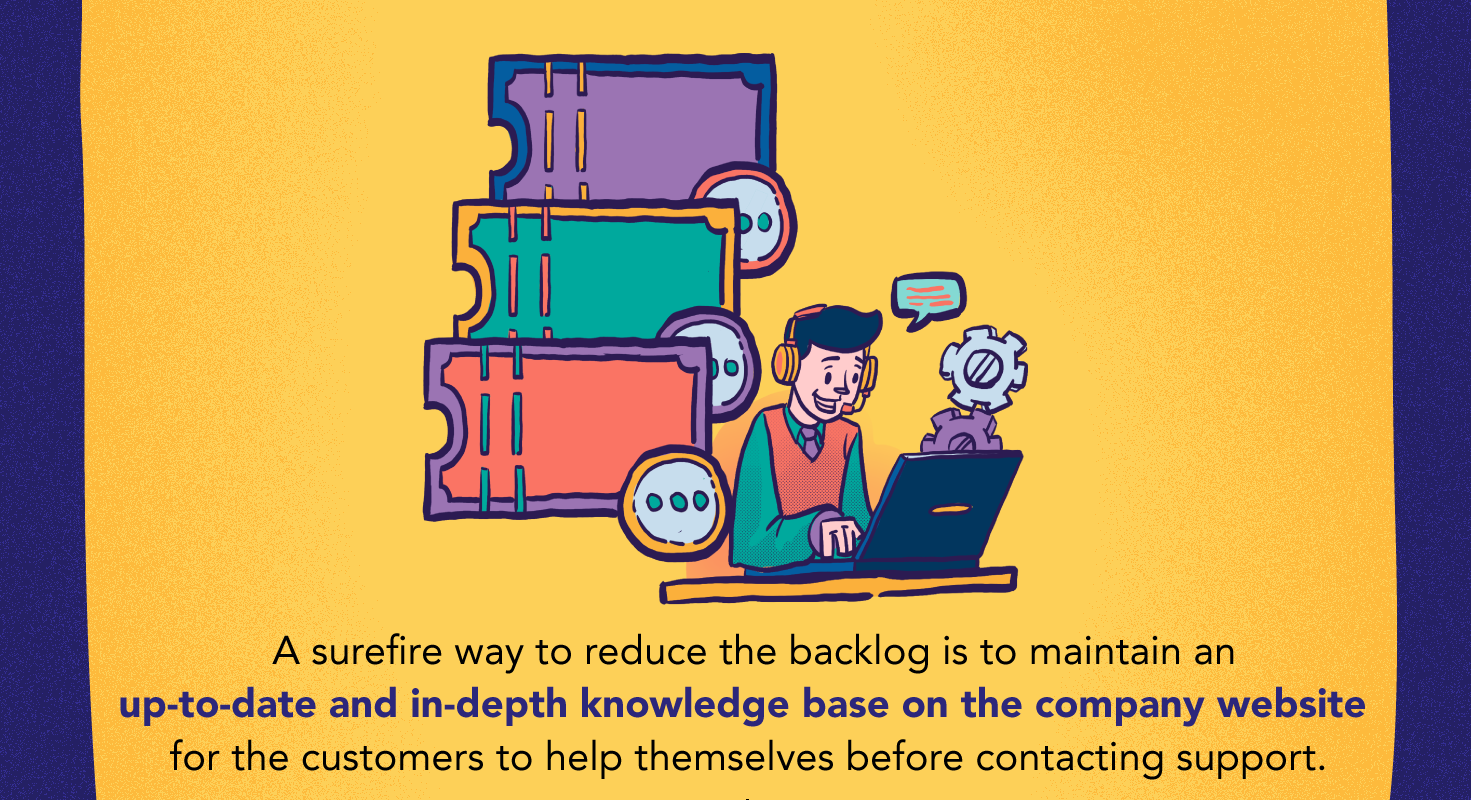
15. Backlog
The backlog refers to those customer service requests that have accumulated over time. It’s important because it measures an agent’s performance and capacity to resolve issues quickly. The higher the backlog, the larger the number of disgruntled customers waiting to fix their problem. A backlog can form for many reasons, such as a large seasonal volume of messages or the team taking longer to resolve issues.
How to Measure: To measure the backlog, choose a reasonable amount of time for resolving customers’ problems, whether that’s 12, 24, or 72 hours. Then count the number of tickets that have been open longer than that amount of time.
Tip: A surefire way to reduce the backlog is to make sure the company’s website offers as much information as possible so customers can help themselves before contacting support. Ensure that the help pages are updated frequently, especially when new products or promotions are added.
16. Self-Service Usage
Empower customers to solve their problems by providing them with the tools they need, such as FAQs, chatbots, and video tutorials. Self-service can free up time for the customer service team to spend their energy solving complex problems rather than fixing the same minor issues daily. In fact, by 2020, customers will be managing 85% of their relationships with companies without interacting with a single human.
How to Measure: One way to measure self-service usage is to look at an analytics report of the total number of searches in your help center. If you’re adding content and searches are increasing, your customers are likely finding the information they need.
Tip: Give customers the chance to engage with other customers and share tips and experiences by creating a forum. Have a moderator on hand to make sure everyone stays on topic.
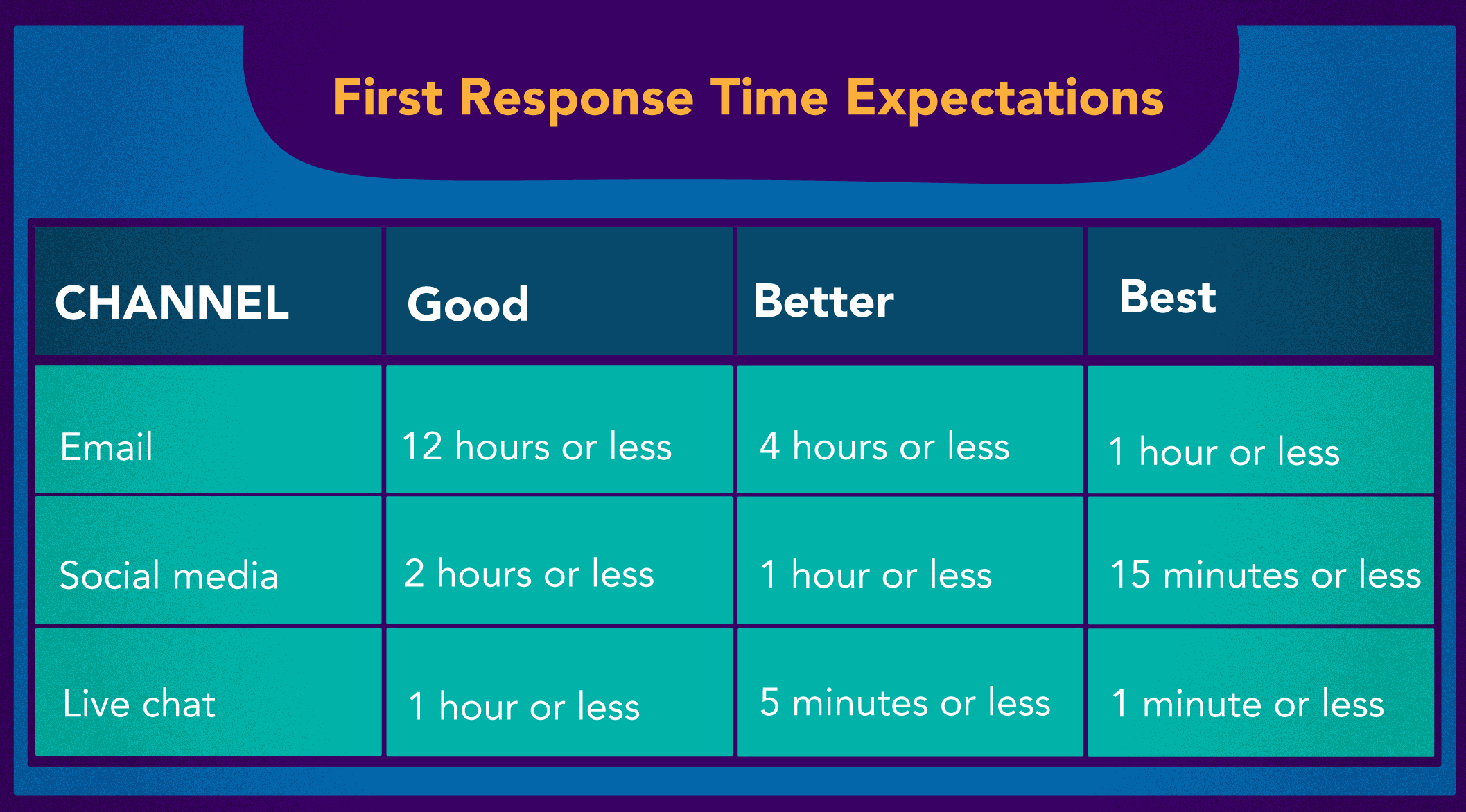
17. First Response Time
It’s the amount of time between when a customer first sends a message and when a customer service agent responds for the first time. In short, it measures how long a customer has to wait before being helped. It’s a crucial metric as 90% of consumers believe that an “immediate” response is essential.
How to Measure: Take the sum of all first response times and divide by the number of cases resolved in that duration to find the average.
Sum of the first response times / Number of cases resolved
Tip: Ensure that customer service reps are not multitasking. Instead of handing multiple chats and phone calls simultaneously, allow them to focus on a single channel, ultimately improving quality and accuracy.
18. Ticket Reopen Rate
This metric is about tickets that have been resolved and then reopened later and may suggest that customer service employees are not solving customers’ issues. Companies need to monitor this metric because it allows them to see if the CX department may be focusing on speed over quality.
How to Measure: Divide the number of reopened tickets by the number of total tickets solved and multiply by 100.
(Number of reopened tickets / Total tickets solved) x 100
Tip: Ensure that all agents have proper training. They should ask clients as many questions as needed to fully understand the issue and involve as many people from other divisions as required to resolve the problem in the first attempt. Make sure that they do not rush through the process.

19. Ticket Volume
This metric lets companies know how many customers need assistance at any point in time. Businesses should track this over time to see if it increases or decreases with improvements to call center management. Any unusual spike or dip in ticket volumes should be investigated to take proper action.
How to Measure: This metric is easy to calculate as it’s simply the sum of all tickets, i.e., the total number of conversations in the support inbox.
Tip: Keeping track of all support issues allows agents to keep customers updated about the status of their case, identify errors or complications early in the game, know who within the department is working on what, and understand how long it takes to resolve specific issues.
20. Cases by Topic
Customer service agents should be tagging and labeling conversations. It will allow management to identify any unusual changes in volume and track it down to the product or service in need of improvements.
How to Measure: The best way to measure cases by topic is to organize conversations by labeling them and tallying them each month. A month-by-month analysis will show which topics need attention the most.
Tip: Assign agents responsible for different support topics. Over time they will become more familiar with the product, service, or issues assigned to them and have the expertise to resolve those problems more quickly.
About 76% of customers believe that customer service is the true reflection of how much a company values them. How you treat your customers and make them feel is more important than ever.
There’s no shortage of metrics to track within the customer service department, but now you know the 20 most important ones you should start monitoring today.
Analyzing these meaningful call center service metrics will provide your company with invaluable insight into your CX department and its processes. These numbers will help you tweak strategies to foster loyalty, boost satisfaction, reduce churn, and, ultimately, increase the bottom line for your company.
Infographic









![What is Omnichannel Customer Service? [Benefits & Tips] What is Omnichannel Customer Service? [Benefits & Tips]](images/omni-channel-explained-350x203.png)

